We use cookies to make your experience better. To comply with the new e-Privacy directive, we need to ask for your consent to set the cookies. Learn more.
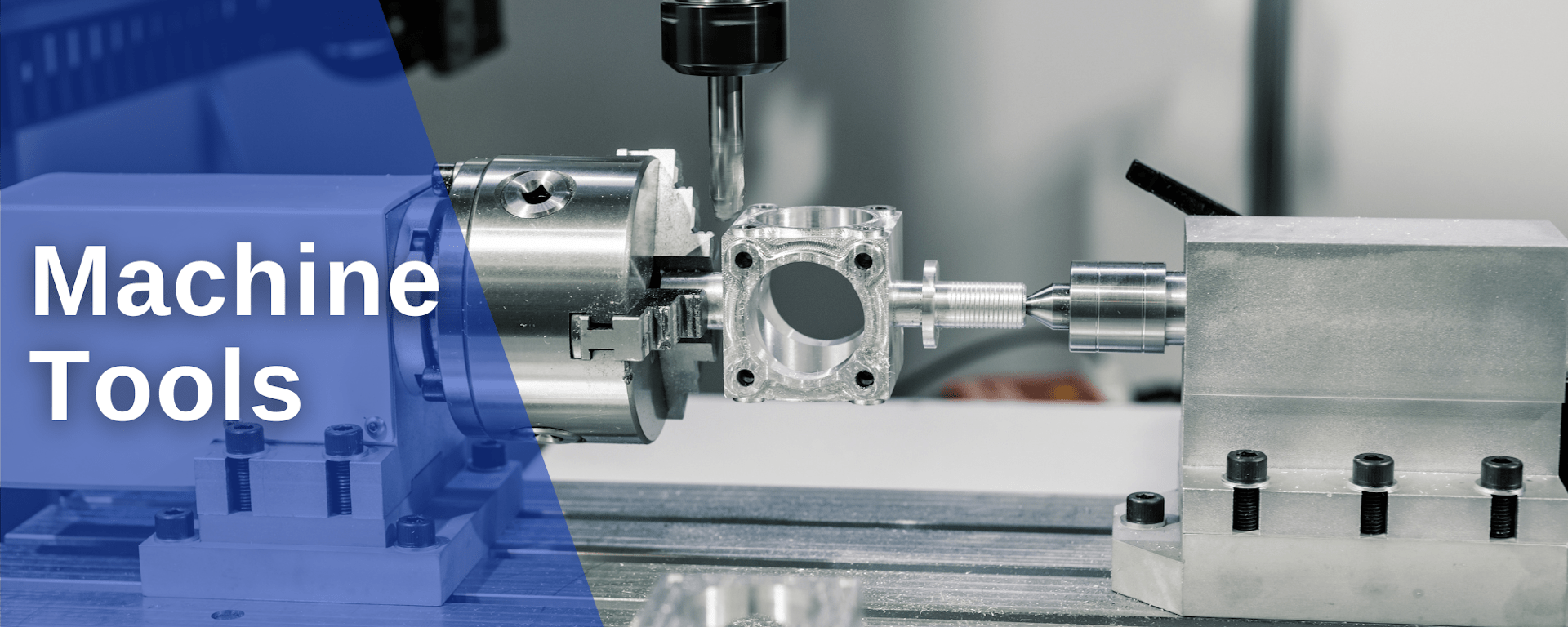
Machine Tools
The machine tools industry is a diverse sector, offering a wide range of products and services. The industry is constantly evolving as new technologies become available and manufacturers strive to meet the demands of the market. Machine tool equipment, such as CNC (Computer Numerical Control) machines, 3D printers, and robotics, are essential for a wide range of functions: shaping, forming, cutting, bending, punching, carving, stamping, and finishing materials. Machine Tool Equipment provides manufacturers a way to achieve high-precision results, and produce high-quality products, at a higher rate of completion that is safer for the operator.
This type of equipment is used in the manufacturing of components used in a wide range of fields, including automotive, aerospace, packaging, and medical devices and surgical tools. Machine tool equipment can also produce parts such as bolts, rods, and other fasteners in many sizes and shapes. Additionally, machine tools can be used to create plastic molds for consumer products like bottles, containers, toys, and more.
Anaheim Automation, Inc. has been providing customers with top-quality components for their machine tools applications for over 55 years. We carry a wide variety of automation solutions, from stepper motors and drivers, to linear components such as linear guides and ball screws. Along with our standard product selection, we also offer customization and value-added services, including assembled Encoders, Cables, Brakes, and Connectors/Cables. Also available are integrated motor solutions, which combine motors, drivers, and/or controllers. Anaheim Automation can even provide fully customized products to satisfy our customers' exact motion control requirements.
Products for Machine Tools
Stepper
The precision, reliability, and overall cost-effectiveness of stepper motors make them an ideal option for applications in the machine tool industry. Stepper motors are popularly used in CNC machines, controlling the axes in material handling and fabrication equipment. Steppers are used for applications requiring a high degree of accuracy and repeatability, such as controlling the axes of robotic arms, and positioning specialized tooling, such as in drill presses and lathes.
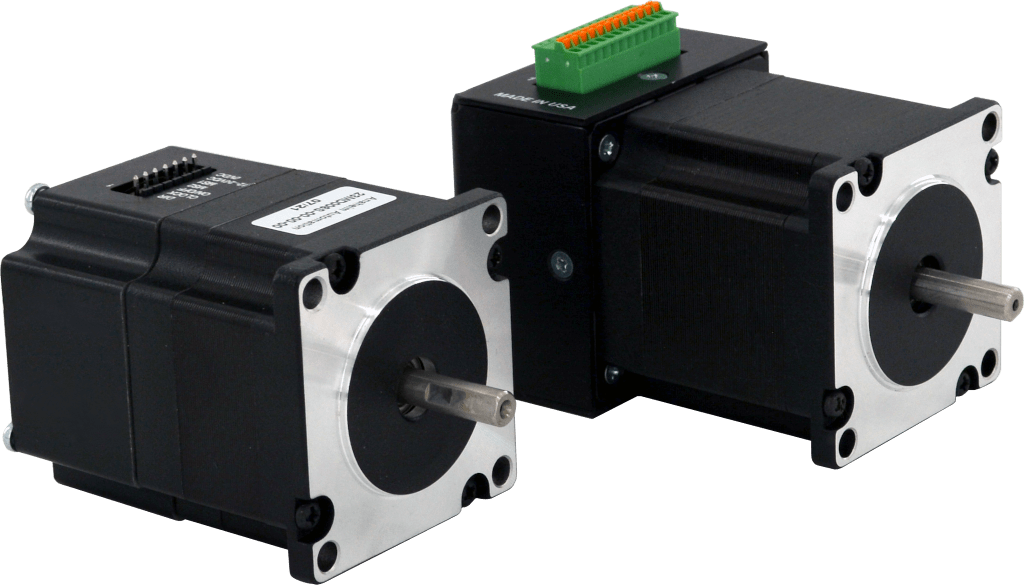
Anaheim Automation offers the most extensive line of Stepper Products in the industry. Our Stepper Motor product line ranges from motor frame sizes NEMA 08 to 42, with torque ranges from 2.5 to 5,700 oz-in, available in IP50 and IP65 designs (model dependent). Our Stepper Drivers are designed and manufactured in-house, and are available in several styles, including printed circuit boards, modular single-axis and multi-axis units, and single- and multi-axis Driver Packs, which include a power supply and/or indexer or controller, in fan-cooled enclosures. Our Stepper Gearmotors are excellent for applications requiring extra torque, and are available in both Planetary and Spur configurations. We also provide integrated stepper motors, available in NEMA sizes 17, 23, and 34 which include our Stepper Motors with Integrated Drivers (17MD, 23MD and 34MD series) and Stepper Motors with Integrated Drivers and Controllers (17MDSI and 23MDIS series). Our Stepper Linear Actuators are ideal for converting rotary motion into linear motion. We offer three types, including Hybrid Stepper Actuators, Permanent Magnet Non-Captive Actuators, and Permanent Magnet Captive Actuators.
All Anaheim Automation stepper motors can be customized to include an encoder, cable and connector, brake, etc. even at small quantities. Stepper motors and actuators with encoders, for example, are especially popular in multi-axis CNC equipment and 3D printing applications. Other customizations, including shaft modifications, special windings, and private-labeling are also available, but may require a Minimum Order Quantity, (MOQ).
Planetary Gearboxes
Planetary gearboxes have many uses in the machine tool industry. For example, they are commonly used in the spindle drive and transmission systems of machine tool equipment, providing power, torque, and speed reduction for the motor. Planetary gearboxes are also used in the feed mechanism, allowing for smooth and precise motion in the linear axes of the machine. They can also be used in positioning and control systems, helping to increase accuracy and efficiency.

Anaheim Automation's line of economical Planetary Gearboxes includes a wide range of options, including Right-Angle and Rotating Output Flange designs, to fulfill a variety of application requirements. Our gearboxes are available in sizes from 40mm to 160mm, compatible with motors from NEMA 17 to NEMA 42, as well as motors with C-Face mounting.
Encoders
Encoders are used to measure position, speed, and direction, and provide precise, real-time feedback regarding the operation of the machine, ensuring that the equipment is running correctly and efficiently. Encoders are commonly used in CNC machines to measure the speed and direction of spindles, as well as the distance travelled between axes, so that the machine can move and position materials, allowing them to be accurately cut, drilled, or milled into the desired shape.
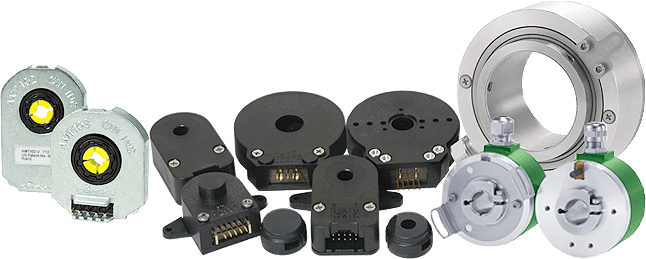
Anaheim Automation carries Optical Rotary Encoders, Magnetic Rotary Encoders, Capacitive Modular Encoders, and Magnetic Linear Encoders. Optical encoders provide precision and accuracy, but are more susceptible to environmental factors than other encoder types. Magnetic encoders are more robust; they are protected from the ingress of dirt, dust, oil, and other environmental factors, but lack the sensitivity of optical encoders. Capacitive encoders combine the best of the other two types into one reliable solution.
Our optical encoder selection includes single-ended, differential, and high-resolution Incremental Optical Encoders. These economical options are able to be mounted to motor shafts ranging from 0.59" to 1.0" in diameter and are capable of tracking up to 200,000 CPS (Cycles Per Second) and 32 to 5,000 CPR (Cycles Per Revolution).
Our magnetic encoders are available in 100 to 65,536 CPR, and can be mounted to motor shafts from 0.125" to 1.125" in diameter, able to track up to 200,000 CPS. These encoders are available with an optional third index channel and differential or open-collector output for U/V/W BLDC motor commutation.
Our AMT10, AMT11S, and AMT11Q encoder series capacitive encoders are able to track up to 4096 PPR (model dependent), and our AMT21 series encoders are "absolute encoders," which are more accurate than incremental encoders.
Linear Components
Linear components are essential to the machine tool industry. Linear Guides include a rail and carriage, or "block" containing ball bearings, allowing the block to travel back and forth along the rail smoothly. This allows tools and objects to be accurately positioned in the workspace. Ball Screws are used to convert rotary motion into linear motion, or vice versa. They consist of a threaded shaft, and a nut which contains ball bearings. The shaft is stationary, and as the nut rotates the ball bearings roll along the grooves, allowing the nut to travel up and down the shaft. This motion is used to control the movement of a tool or object, including speed, direction, and force. Lead Screws provide a robust, low-cost alternative to ball screws, operating in a similar manner to ball screws. They are also comprised of a threaded shaft and nut, although lead screw nuts do not contain ball bearings. Lead screws are precision-machined to provide smooth, continuous motion, and require less maintenance than other linear motion components. Ball Splines are similar to ball screws in that they use a nut with internal ball bearings to ensure smooth motion as the nut travels along the shaft. However, they are more precise than ball screws and lead screws, and offer smoother, lower-friction motion as well as being lightweight and able to accommodate high speeds.
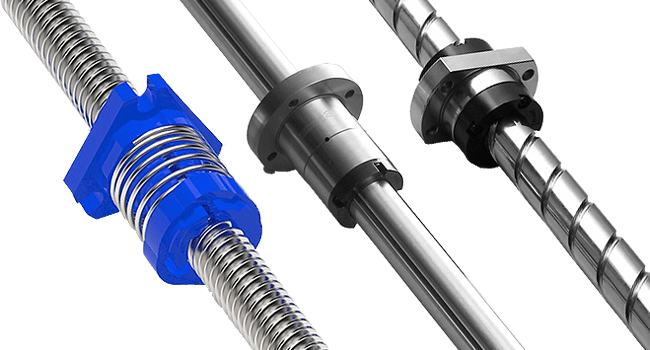
Anaheim Automation offers a broad selection of Linear Components and Linear Component Accessories, such as ball screw support units, metal stoppers, and lubrication kits. Our linear components are designed to maximize quality, durability, and reliability while remaining affordable.
Our ball screws are available in diameters from 4mm to 80mm and lengths up to 7,000mm, with a range of nut, preload, accuracy, and travel options. Custom end-machining is available at an additional cost. When making a selection, customers can fill out our Ball Screw Application Sheet with their requirements and our engineers will recommend the most suitable model for a given application.
Our competitively priced linear guides are offered in rail widths from 3mm to 63mm, with lengths up to 4,000mm. There are a number of block options available in various widths, heights, and preload classes, as well as the option for reinforced end seals.
Our lead screws come in screw diameters from 0.125" to 1.00", with 0.024" to 3.0" leads, with either right or left-hand threads and multiple nut variations. These units are "self-locking," meaning that back-driving will not occur when the screw lead is less than 1/3 the diameter for uncoated screws, or 1/4 the diameter for PTFE coated screws.
Our ball splines are available in diameters from 6mm to 50mm, in solid and hollow-spline formats, in three accuracy grade options and three preload options. Nuts are offered in either flange or cylindrical styles.
Servo
Due to their high power density, Servo Systems consisting of a Servo Motor and Servo Drive are frequently used in the machine tool industry to control the speed, direction, acceleration, and positioning of equipment, such as in cutting and drilling machines. The drive provides the power and programming to the motor, so that it can move the machine in the desired motion. An internal encoder provides motor feedback, creating a closed-loop control system, so that users can monitor and make adjustments accordingly. This allows for higher accuracy and faster production times, as well as saving on energy consumption.
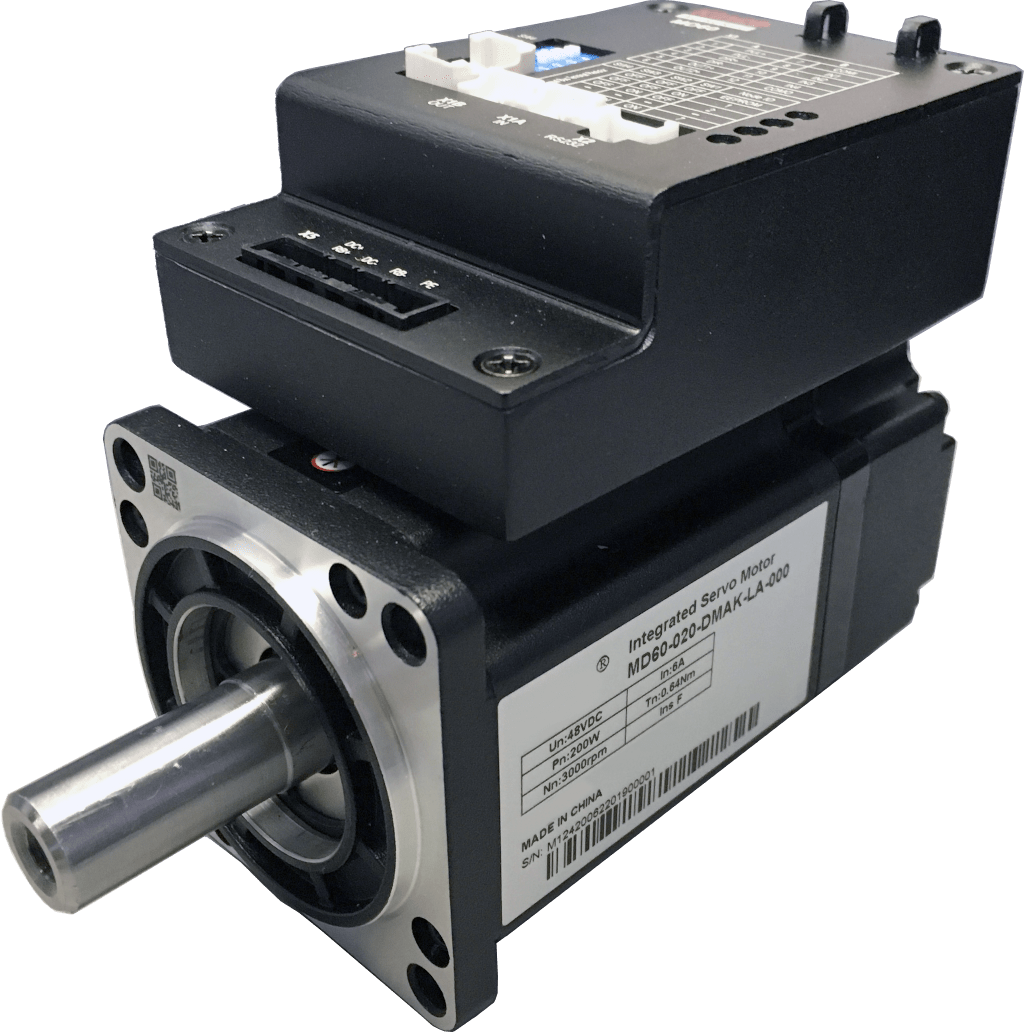
Anaheim Automation carries a variety of competitively-priced servo products, including 50 to 5,000 Watt motors and drives, 120VAC and 240VAC packaged systems, and 24 to 70VDC Servo Motors with Integrated Drives. With torque ranges from 273 to 16,299 oz-in and 224 to 2,447N of force (model dependent), we can meet the requirements of nearly any application.
HMI/PLC
HMIs (Human Machine Interfaces) are used to monitor, control, and troubleshoot issues in machine tool machinery. They provide a user-friendly graphical interface, which allows the operator to interact with the machine tool and its functions by giving commands to the PLC. PLCs (Programmable Logic Controllers) control the machine tool processes by running a program stored in the PLC's memory. This program is written in a programming language, such as "ladder logic," and allows the PLC to control the physical equipment. When used together, HMIs and PLCs provide a complete control solution for machine tool processes.

Our HMIs are available in 256K color displays with screen sizes ranging from 4.3" to 15.0", 32-bit RISC processors, and speeds from 400 to 1.6GHz (model dependent). We also offer a selection of specialty HMIs, including water-resistant and splash-proof options. Our powerful block-style PLC modules are easily connected to our HMIs, and are capable of expansion up to 136 I/O points. Integrated HMI/PLC combination units are available in 4.3" or 7.0" display sizes, and include all of the features of our standalone HMI and PLC units in one compact package.
BLDC Motors
Brushless DC Motors are motors that do not utilize brushes to transfer current to the rotor. This enables them to run at high speeds efficiently and reliably, as well as reducing maintenance that would be required with brushed motors. Due to their brushless construction, they are frequently used in the machine tool industry to provide precise control of speed and torque, which is essential for proper machining. BLDC motors are energy-efficient and have a long life expectancy, which can help to reduce overall costs. These motors are well-suited for applications that require frequent starts and stops, such as in CNC machines and lathes, as they are capable of high power density for handling large loads without experiencing torque ripple or loss of torque.

Anaheim Automation carries a large selection of BLDC motors in frame sizes ranging from 16mm to 86mm, as well as Brushless Gearmotors in both Planetary and Spur types, Brushless Motors with Integrated Speed Controllers from 1.7" to 3.4" frame sizes, and BLDC Linear Actuators with Ball Screws in 42mm and 57mm frame sizes. All of our BLDC motors can be customized to include an encoder, cable and connector, brake, etc. even at small quantities. Other customizations such as shaft modifications, custom voltages and currents, private-labeling, etc. are also available, but may require a Minimum Order Quantity (MOQ).
Common Applications
CNC Equipment

CNC Machines – CNC (Computer Numerical Control) machines are pieces of equipment used in automated manufacturing and fabrication processes. They are programmed to move in specific directions and distances at precise speeds, and can be used for a variety of tasks, such as cutting, drilling, milling, engraving, laser cutting, 3D printing, and shaping metal and other materials. CNC machines are extremely accurate, providing a higher level of precision and efficiency compared to traditional machines or manual labor, reducing production time and costs. They are used in a variety of industries, including automotive, aerospace, bio-medical, metal fabrication, and anywhere else highly-precise and complex parts or components are required.
Products for CNC Machinery
HMIs
HMIs are used to provide a user-friendly interface between the operator and the CNC machine, allowing the operator to control all aspects of the CNC machine, including the speed, feed rate, and machine parameters. They can also be used to display visual feedback of the machine's current status and provide alerts and messages when there are errors or warnings, alerting the operator of any potential issues so that they can be addressed in a timely manner. Providing the operator with this information helps to ensure the CNC machine is running safely and efficiently.
Servo
Servo motors operate on a closed-loop system to transfer information to the CNC machine. AC and DC servos have high accuracy and resolution owing to a sensor-fixed encoder. Their high torque-to-inertia ratio enables rapid load acceleration, and with lighter loads efficiency may reach up to 90%. The motor is powered by the servo amp, which also counts each step made.
Linear Guides
Linear guides translate the rotary motion of the motor into linear motion along X-Y or X-Y-Z axes. The motion is then translated to the toolhead, allowing the CNC to accurately cut, mill, or otherwise shape materials. Linear guides are resistant to dirt, dust, and other debris, making them ideal for use in environments where particulates from the material being shaped will be present.
3D Printing
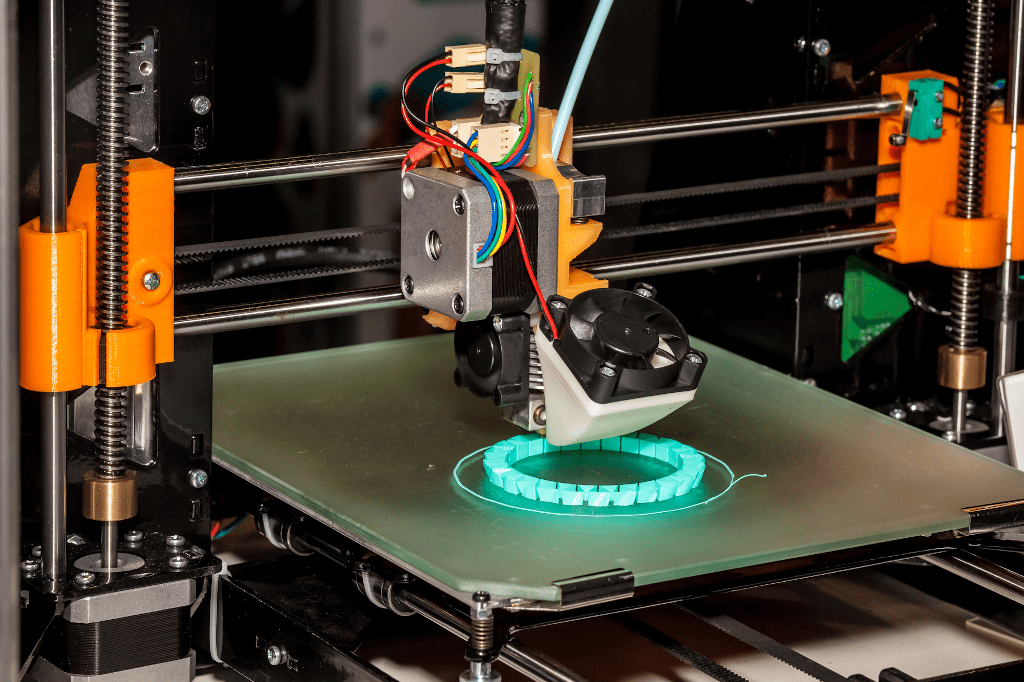
3D Printers – Industrial 3D printing is revolutionizing the way manufacturers create products. The process of transforming a digital 3D model into a physical object using a variety of materials, including plastics, metals, and composites, allows manufacturers to produce complex parts quickly for faster prototyping and production. 3D printing is used in a variety of industries, from aerospace to consumer goods - even creating tools and parts that previously have been difficult or impossible to produce using traditional methods. 3D printing has become an increasingly popular option for manufacturers looking to reduce costs and improve turnaround times without sacrificing the quality of end products.
Products for 3D Printing
Stepper Motors and Drivers
Steppers are best for processes which require a series of equal, consistent movements. Stepper motors are used in 3D printers to move the print head, which is the part of the printer that extrudes the filament, in precise discrete steps, and can accurately hold their position. Steppers are highly reliable and accurate due to the way they rotate in fixed intervals, making them ideal for this type of application. Stepper drivers provide the current necessary for the motor to move the print head, allowing for the speed and direction of the motor to be adjusted to specific application requirements.
Ball Screws
Ball screws are an ideal option for 3D printing applications. As the motor operates, the ball screw nut rotates along the screw in a linear motion, moving the print head to the required location. Due to their low friction, they are more accurate and better-performing than other drive train options, such as belt-drives, allowing the 3D printer to produce more precise, high-quality items.
Encoders
The 3D print head can use one or more encoders to track its position within the workspace. Data from the encoder is transmitted back to the motor to verify position and adjust the motor's speed and direction as needed.
Industrial Lathes

Industrial Lathes – Industrial lathes are powerful tools used to shape and cut metal, wood, composites, and other materials. They are typically used to create components for machines, vehicles, and other equipment with precision and repeatability, ensuring consistent and reliable results. Industrial lathes typically feature a cutting head which rotates while the material is fed into it. This allows the operator to create complex shapes and profiles with ease. Lathes can also be used for a variety of other tasks, such as drilling, reaming, knurling, and milling.
Products for Industrial Lathes
Planetary Gearboxes
Planetary gearboxes provide a high power-to-weight ratio, allowing for a lighter and more efficient machine. This can help maximize the production rate while minimizing energy consumption. Additionally, their high torque capacity enables them to handle large cutting forces, and allows for greater precision and accuracy, especially when machining hard or dense materials. Furthermore, planetary gearboxes are available in a wide range of gear ratios, giving the lathe greater control over different speeds.
Stepper Motors
Hybrid stepper motors combine the best features of steppers and servos into one compact package, and they are often used in lathe machines due to their high precision and speed capabilities. The motor moves the lathe's spindle in precise increments, allowing for exact positioning. Steppers may also be used in lathe applications to control the speed of the spindle, or to move the tool/workpiece or the item being machined.
BLDC Motors
Brushless DC motors are widely used in industrial lathe machines due to their superior performance and reliability. BLDC motors offer several advantages over traditional brushed motors, including higher efficiency, low noise and vibration, and longer life expectancy. They are also typically more lightweight than comparable brushed motors, allowing for a smaller and more lightweight machine design. BLDC motors provide precise and consistent speed control, improving the machine's cutting speed and accuracy and allowing for more efficient production.
